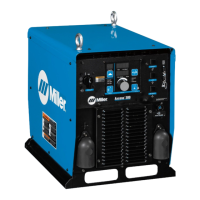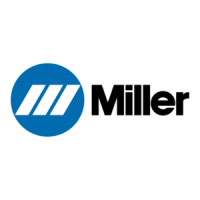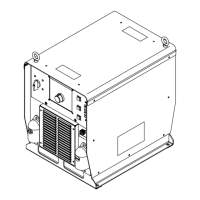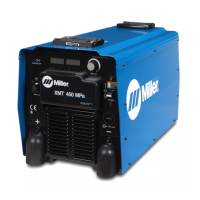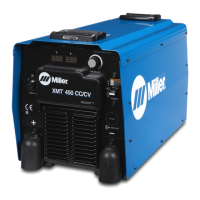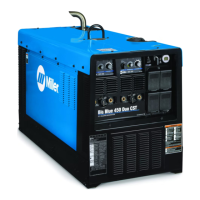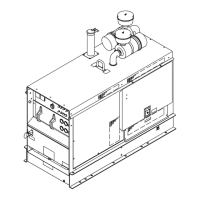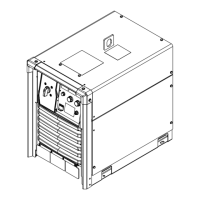How to restore 115 volts AC at the duplex receptacle on Miller Axcess 450?
- SStacey HamiltonAug 16, 2025
If there is no 115 volts AC at the duplex receptacle on your Miller Welding System, reset the supplementary protector CB1.
How to restore 115 volts AC at the duplex receptacle on Miller Axcess 450?
If there is no 115 volts AC at the duplex receptacle on your Miller Welding System, reset the supplementary protector CB1.
What to check if gas does not flow on Miller Axcess 450 Welding System?
If the gas in your Miller Welding System does not flow, or does not stop flowing while the wire feeds, check the gas valve and flow meter.
Why does wire feed as soon as power is supplied on Miller Welding System?
If the wire feeds as soon as power is supplied to your Miller Welding System, check the gun trigger, consulting the gun Owner’s Manual.
Why wire burns back to gun contact tip on Miller Axcess 450?
If the wire burns back to the gun contact tip when using an electrode negative process on your Miller Welding System, ensure that the volt sense lead is connected to the work.
How to fix Miller Axcess 450 Welding System with no weld output?
If your Miller Welding System is completely inoperative with no weld output, first ensure the line disconnect is in the On position. Then, check and replace the line fuses if necessary, or reset the circuit breaker. Finally, verify that the input power connections are properly connected.
Why does the wire feed erratically on my Miller Welding System?
If the wire feed on your Miller Welding System is erratic, try these steps: 1. Readjust the hub tension. 2. Readjust the drive roll pressure. 3. Clean or replace any dirty or worn drive rolls. 4. Remove any weld spatter around the nozzle opening. 5. Replace the contact tip or liner, consulting the gun Owner’s Manual. 6. Check the motor control cable connections.
What to do if Miller Welding System has erratic weld output?
If your Miller Welding System shows erratic or improper weld output without displaying any errors, ensure that you are using the correct size and type of weld cable. Also, clean and tighten all weld connections.
How to troubleshoot Miller Axcess 450 Welding System when wire does not feed?
If the wire isn't feeding in your Miller Welding System, check the supplementary protector CB2 and reset it if needed. Also, inspect the motor control cable connections.
Why Miller Axcess 450 Welding System has no weld output but meter display is on?
If your Miller Welding System's meter display is on but there's no weld output and no error is displayed, check if the contactor indicator light is lit when the contactor line is asserted on.
What causes wire stubbing on Miller Axcess 450 Welding System?
If the wire is stubbing on the low end while using a constant current power source with your Miller Welding System, increase the output setting of the power source. Also, check the voltage sense lead connection and clean and tighten it if necessary.
Describes the welding types supported by the unit.
Details the unit's function as an automatic welding interface.
Discusses company history and dedication to product quality.
Explains the manual's structure and benefits for users.
Explains safety symbols used throughout the manual.
Covers fundamental risks associated with arc welding.
Details risks from arc rays and flying particles.
Warns about flammable materials and hazardous gas buildup.
Covers burns from hot components and pacemaker interference.
Addresses hearing damage risks and cylinder handling safety.
Covers fire, falling unit, and static discharge risks during installation.
Details risks from moving parts and welding wire during operation.
Lists state-specific chemical warnings for California.
Lists relevant industry safety standards for welding.
Discusses electromagnetic fields and mitigation strategies.
Lists power, voltage, wire feed, and dimensions of the unit.
Provides physical size and weight details of the welding unit.
Explains operational limits and heat management for the unit.
Shows the output capabilities of the power source.
Guides on choosing a suitable installation site for the unit.
Illustrates how various components connect to the unit.
Describes ports and protectors on the rear panel of the unit.
Details how to correctly connect output terminals for welding.
Explains functions of the network wire feeder receptacle.
Explains functions of the optional E-stop receptacle.
Provides guidance on input power and wiring requirements.
Step-by-step guide for connecting the unit's input power.
Guidance on choosing appropriate cable gauges for welding.
Explains how to minimize circuit loop for optimal performance.
Methods to reduce magnetic field effects from cable arrangements.
Guidelines for setting up and using multiple welding power sources.
Illustrates incorrect voltage sensing connections for multiple arcs.
Shows improved voltage sensing connections for multiple arcs.
Demonstrates optimal voltage sensing connections for multiple arcs.
Describes the function of switches and indicators on the front panel.
Details available add-on functionalities like E-Stop and DeviceNet.
Outlines periodic checks and cleaning tasks for the unit.
Instructions for blowing out dust and debris from the unit's interior.
Explains safety symbols specific to the servicing section.
Highlights risks during repair and maintenance operations.
Covers hazards from mechanical parts and RF radiation during servicing.
Includes general warnings, California Prop 65, and EMF precautions.
Procedure to safely check capacitor charge before servicing.
Explains the meaning of status LEDs on the process control board.
Details status indicators for network and module connectivity.
Provides remedies for typical operational problems and errors.
Presents the internal wiring schematic of the welding power source.
Shows components of the primary unit assembly.
Details parts for the windtunnel assembly.
Lists components for the top tray assembly.
Shows components of the rear panel assembly.
Lists components of the front panel assembly.
Details the terms and periods of the manufacturer's warranty.
Space for recording personal equipment details.
Provides contact details for customer support and service.
Describes the welding types supported by the unit.
Details the unit's function as an automatic welding interface.
Discusses company history and dedication to product quality.
Explains the manual's structure and benefits for users.
Explains safety symbols used throughout the manual.
Covers fundamental risks associated with arc welding.
Details risks from arc rays and flying particles.
Warns about flammable materials and hazardous gas buildup.
Covers burns from hot components and pacemaker interference.
Addresses hearing damage risks and cylinder handling safety.
Covers fire, falling unit, and static discharge risks during installation.
Details risks from moving parts and welding wire during operation.
Lists state-specific chemical warnings for California.
Lists relevant industry safety standards for welding.
Discusses electromagnetic fields and mitigation strategies.
Lists power, voltage, wire feed, and dimensions of the unit.
Provides physical size and weight details of the welding unit.
Explains operational limits and heat management for the unit.
Shows the output capabilities of the power source.
Guides on choosing a suitable installation site for the unit.
Illustrates how various components connect to the unit.
Describes ports and protectors on the rear panel of the unit.
Details how to correctly connect output terminals for welding.
Explains functions of the network wire feeder receptacle.
Explains functions of the optional E-stop receptacle.
Provides guidance on input power and wiring requirements.
Step-by-step guide for connecting the unit's input power.
Guidance on choosing appropriate cable gauges for welding.
Explains how to minimize circuit loop for optimal performance.
Methods to reduce magnetic field effects from cable arrangements.
Guidelines for setting up and using multiple welding power sources.
Illustrates incorrect voltage sensing connections for multiple arcs.
Shows improved voltage sensing connections for multiple arcs.
Demonstrates optimal voltage sensing connections for multiple arcs.
Describes the function of switches and indicators on the front panel.
Details available add-on functionalities like E-Stop and DeviceNet.
Outlines periodic checks and cleaning tasks for the unit.
Instructions for blowing out dust and debris from the unit's interior.
Explains safety symbols specific to the servicing section.
Highlights risks during repair and maintenance operations.
Covers hazards from mechanical parts and RF radiation during servicing.
Includes general warnings, California Prop 65, and EMF precautions.
Procedure to safely check capacitor charge before servicing.
Explains the meaning of status LEDs on the process control board.
Details status indicators for network and module connectivity.
Provides remedies for typical operational problems and errors.
Presents the internal wiring schematic of the welding power source.
Shows components of the primary unit assembly.
Details parts for the windtunnel assembly.
Lists components for the top tray assembly.
Shows components of the rear panel assembly.
Lists components of the front panel assembly.
Details the terms and periods of the manufacturer's warranty.
Space for recording personal equipment details.
Provides contact details for customer support and service.
| Rated Output | 450 A at 38 VDC, 100% Duty Cycle |
|---|---|
| Input Power | 50/60 Hz |
| Welding Processes | MIG, Flux Cored |
| Wire Diameter Range | 0.6mm |
| Net Weight | 68kg |
| Wire Feed Speed | 50–800 ipm (1.3–20.3 m/min) |
